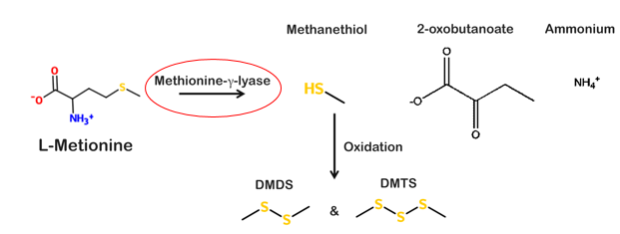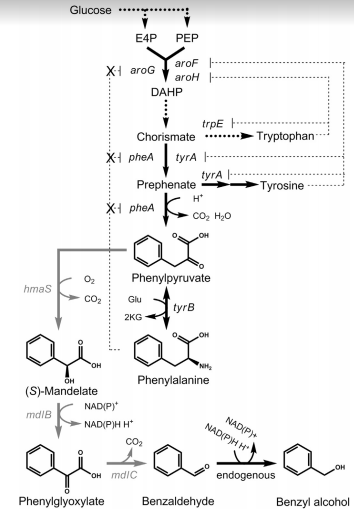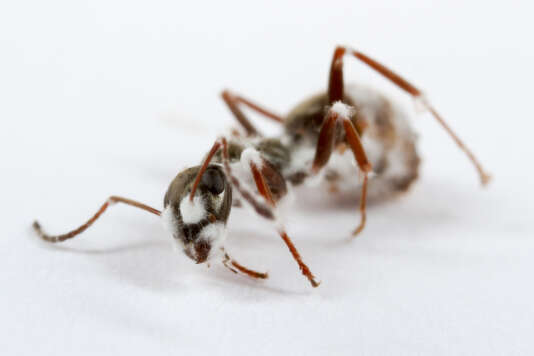{{{title}}}
Design
Design is the first step in the design-build-test cycle in engineering and synthetic biology. Use this page to describe the process that you used in the design of your parts. You should clearly explain the engineering principles used to design your project.
This page is different to the "Applied Design Award" page. Please see the Applied Design page for more information on how to compete for that award.
What should this page contain?
- Explanation of the engineering principles your team used in your design
- Discussion of the design iterations your team went through
- Experimental plan to test your designs
Inspiration
Contents
Pheromones
DMDS DMTS
One part of our project is based on the use of pheromones to attract bed bugs in our trap. Some studies have shown that dmds (dimethyl disulfide) and dmts (dimethyl trisulfide) are the most attractive pheromones for bed bugs [1]. Otherwise, those molecules are present in bed bugs dejections, which allows them to find back their colonies when they go outside in the night. In order to make the bed bugs coming into the trap, we want to creat an enginered E. coli, that will produce those 2 pheromones. Such a work have already been realised by the Wageningen UR iGEM team in 2014 [2]. We have decided to based this part of the project on their, and ameliorate it by making activity test [3]. The DMDS and DMTS biosynthesis pathway degrades sulfur-containing amino acids to thiol, ammonia and alpha keto-acids by using methionine gamma-lyase (MGL). Those produts are then naturally oxidated to DMDS ans DMTS as shown below:
E.coli bacteria is a good model organism to do such a construction, as it produces L-methionine by itself [5].
Methionine gamma lyase (MGL)
For this project we used a mgl enzyme from Brevibacterium linens organism. This MGL protein is an enzyme that belongs to the family of trans-sulfuration enzymes family. It is made up of 425 amino acids and catalyses the chemical carbon-sulfur lyase reaction [6][7][8]
Benzyl alcohol
The project goal is to eliminate bed bugs by using enginered E. coli bacteria that can produce DMDS and DMTS pheromones, and by creating a contact between Beauveria Bassiana and the bed bug that will come into the trap. It will come back then to its colony and infect other bed bugs with our fungus when it will die. This infection will hapenned by fungus sporulation, and also by the contact with the infected cuticule.
The problem we met through our research is that DMDS and DMTS have growth inhibitors effect on filamentous fungus [9].
That is why we’ve decided to creat an other enginered E.coli strain, that could produce benzyl alcohol. Benzyl alcohol is also a pheromone that can attract bed bugs[10]. In association with DMDS and DMTS pheromones we will creat a great attractive pole into the trap.
To do so, we’ve decided to insert a no-natural pathway in an E. coli strain, that derived of an other natural pathway, which is the glucose degradation in phenylalanine. This process aims to use the phenylpyruvate (one of this natural pathway’s substrats) in order to start the benzyl alcohol biosynthesis pathway. It needs 3 differents enzymes:
4-hydroxyphenylpyruvate dioxygenase, (S)-mandelate dehydrogenase and benzoylformate decarboxylase, which are respectivly encoded by hmaS, mdlB and mdlC genes.
We worked on those 3 differents genes, coming from different organism : Pseudomonas fluorescens (mdlB and mdlC) and Amycolatopsis orientalis (hmaS), because of there similitudes with E.coli.
Those genes will be united as an operon with an RBS and strong promoteur construction, and that operon will be insert into a plasmid that will be introduced into an E.coli enginered strain.
But the first tests were done on 3 differents E.coli strain, each one transformed with an insert-plasmid construction (hmaS, mdlB or mdlC)
hmaS
4-hydroxyphenylpyruvate synthase, or 4-hydroxyphenylpyruvate dioxygenase 2 is an enzyme that catalyzes the chemical reaction bellow, by acting as a decarboxylase and a hydroxylase: 4-hydroxyphenylpyruvic acid + O2 <=> 4-hydroxymandelate+ CO2. It belongs to oxidoreductases family and is involved in the vancomycin biosynthesis pathway. This enzyme is expressed by hmaS gene, that is present in Amycolatopsis orientalis. It is the first benzyl alcohol pathway step for its biosynthesis.
Beauveria Bassiana :
Entomopathogenic fungi are natural biopesticides acting through contact. Beauveria Bassiana is capable of infecting a broad range of insect hosts like bed bugs. Our goal is fighting bed bugs worldwide invasive pests, that are invading homes and biting humans for their blood.
Beauveria bassiana was first used as a way of fight against insects in agriculture in Canada, and later on, all over the world. The fungus can easily penetrate bed bug's exoskeleton: the cuticle. Once inside the insect's hemolymph, the fungus feeds and multiplies, causing its death [12].
In the wolrd, entomopathogenic fungi are common and widespread in almost all classes of insects. Only a few of fungi are currently being developed as pathogens against inset pests. Indeed, entomopathogenic fungi are effective against eggs, larvae, intermediate stages and adults. Beauveria bassiana is a white muscardine fungus, originally known as Tritirachium shiotae, grows naturally in soils throughout the world and acts as a pathogen on various insect species causing white muscardine disease [14] [15].
So, our goal is to use this fungus to fight bed bugs. Indeed, the fungus can easily penetrate bed bug's cuticle like we said before. Our objective is to enhance the fungus so that it is highly virulent for bed bugs. We want to reduce the lethal doses and break the bugs. Especially since, the excessive use of insecticides thickened the bed bug's cuticle. As a result, pest control companies are obliged to increase the insecticides doses.
We started with a first test with our Beauveria bassiana sample on garden bugs. Then, we tested the ability of this fungus to grow on different culture media. Now, we tested Beauveria bassiana on real conditions with bed bugs.





